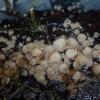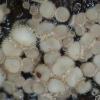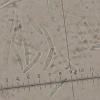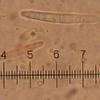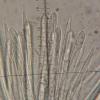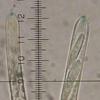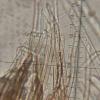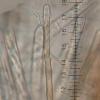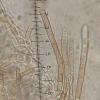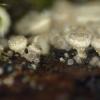
06-01-2013 23:30
 Yannick Mourgues
Yannick Mourgues
Bonsoir.Trouvé au bord d'un ruisseau. Sur Salix d

07-01-2013 13:29
Hi againI need your help for to try this small, gr

05-01-2013 22:19
 Alex Akulov
Alex Akulov
Dear FriendsI need your help very much. I study sa

07-01-2013 01:58
Esquivel-Rios EduardoHi All.This fungi was found in a dead trunk, resem

05-01-2013 10:27
 Joop van der Lee
Joop van der Lee
This asco looks like Delitschia Didyma as far as

10-12-2012 11:19
 Joop van der Lee
Joop van der Lee
This one was found on cow dung. Fruitbody is white

01-01-2013 16:51
Gernot FriebesHi,a friend sent me this tiny ascomycete growing o

01-01-2013 22:56
Salvador TelloApotecios de color marrón, entre 0,5 y 2 mm, sobr
Asco on decorticated Salix
Yannick Mourgues,
06-01-2013 23:30
 Bonsoir.
Bonsoir.Trouvé au bord d'un ruisseau. Sur Salix décortiqué.
Spores 19,9-32,9x3,6-4,6 um, N=30, hyalines sans guttules, 1 cloison en général puis 3 cloisons.
Asques IKI+, 110-130x6-8 um, spores obliquement bisériées.
Paraphyses lancéolées, débordant les asques de 10 à 20 um. Larges jusqu'à 6-8 um.
Poils marginaux bruns, paroi peu épaisse, apex arrondi sans cristaux, incrustations très fines sur les 2 dernières cellules. Souvent agglomérés au sommet dans un espèce de gel.
Excipulum ectal textura globulosa. Sous hyménium textura intrica.
Une idée ?
Yannick
Hans-Otto Baral,
06-01-2013 23:38

Re : Asco on decorticated Salix
Great! This is Lasiobelonium belanense?
I did not want to put a question mark, this was accidental. It is L. belanense.
Zotto
I did not want to put a question mark, this was accidental. It is L. belanense.
Zotto
Yannick Mourgues,
08-01-2013 17:54

Re : Asco on decorticated Salix
Thank's a lot Zotto !
Yannick
Yannick
Martin Bemmann,
08-01-2013 18:12

Re : Asco on decorticated Salix
Hi,
these questionmarks seem to be a bug of the forum-software...
Maybe Christian could check for a solution. The meaning of a posting can be twisted by involuntarily? addition..
Regards,
Martin
Edit: I did NOT insert this questionmark after involuntarily!
these questionmarks seem to be a bug of the forum-software...
Maybe Christian could check for a solution. The meaning of a posting can be twisted by involuntarily? addition..
Regards,
Martin
Edit: I did NOT insert this questionmark after involuntarily!
Hans-Otto Baral,
08-01-2013 18:17

Re : Asco on decorticated Salix
Incredible! and how did you provoke the question mark?
By simply forgetting the fullstop
Zotto
P.S. no questionmakr came after fullstop...
By simply forgetting the fullstop
Zotto
P.S. no questionmakr came after fullstop...
Christian Lechat,
08-01-2013 18:56

Re : Asco on decorticated Salix
Hi to all,
I don't know why a question mark fills the gaps, I'm asking to the technician and I will say to you what is the situation
Cheers,
Christian
PS: no full stop after situation
I don't know why a question mark fills the gaps, I'm asking to the technician and I will say to you what is the situation
Cheers,
Christian
PS: no full stop after situation
Yannick Mourgues,
08-01-2013 19:02

Re : Asco on decorticated Salix
Salut Christian.
Tu pourrais nous traduire ce qui s'est dit ? Je n'y comprends rien, quel est le problème ?
Y
Tu pourrais nous traduire ce qui s'est dit ? Je n'y comprends rien, quel est le problème ?
Y
Christian Lechat,
08-01-2013 19:20

Re : Asco on decorticated Salix
salut Yannick,
il se trouve que l'orsqu'on place deux espaces au lieu d'un par exemple, le second espace est remplacé par un point d'interrogation, ou en fin de phrase, si tu mets un espace après le point final, cet espace est remplacé par un ? ce qui peut changer le sens de cette phrase.
Amitiés,
Christian
il se trouve que l'orsqu'on place deux espaces au lieu d'un par exemple, le second espace est remplacé par un point d'interrogation, ou en fin de phrase, si tu mets un espace après le point final, cet espace est remplacé par un ? ce qui peut changer le sens de cette phrase.
Amitiés,
Christian
Chris Yeates,
08-01-2013 22:47

Re : Asco on decorticated Salix
It's a little annoying, but very easy to then edit the post afterwards (using the Update / Modifier button) - a minor problem compared to the positives of ASCOFrance!
C'est un peu ennuyeux, mais très facile à modifier, pour le poste par la suite - un problème mineur par rapport aux aspects positifs de ASCOfrance!
Chris
C'est un peu ennuyeux, mais très facile à modifier, pour le poste par la suite - un problème mineur par rapport aux aspects positifs de ASCOfrance!
Chris
Hans-Otto Baral,
08-01-2013 22:56

Re : Asco on decorticated Salix
Yes, but I was unaware of that and detected the error only some days later....
Zotto
Zotto
